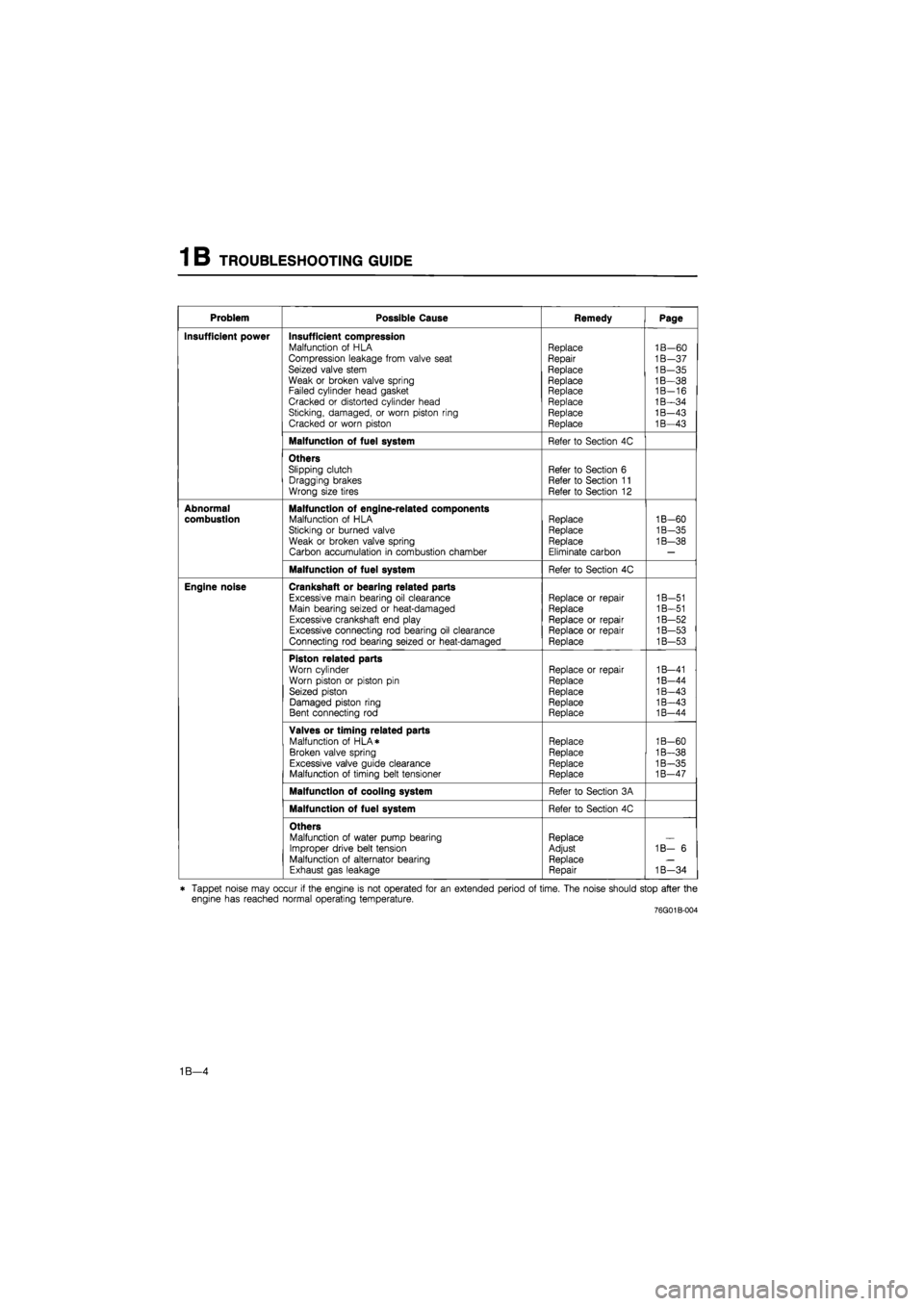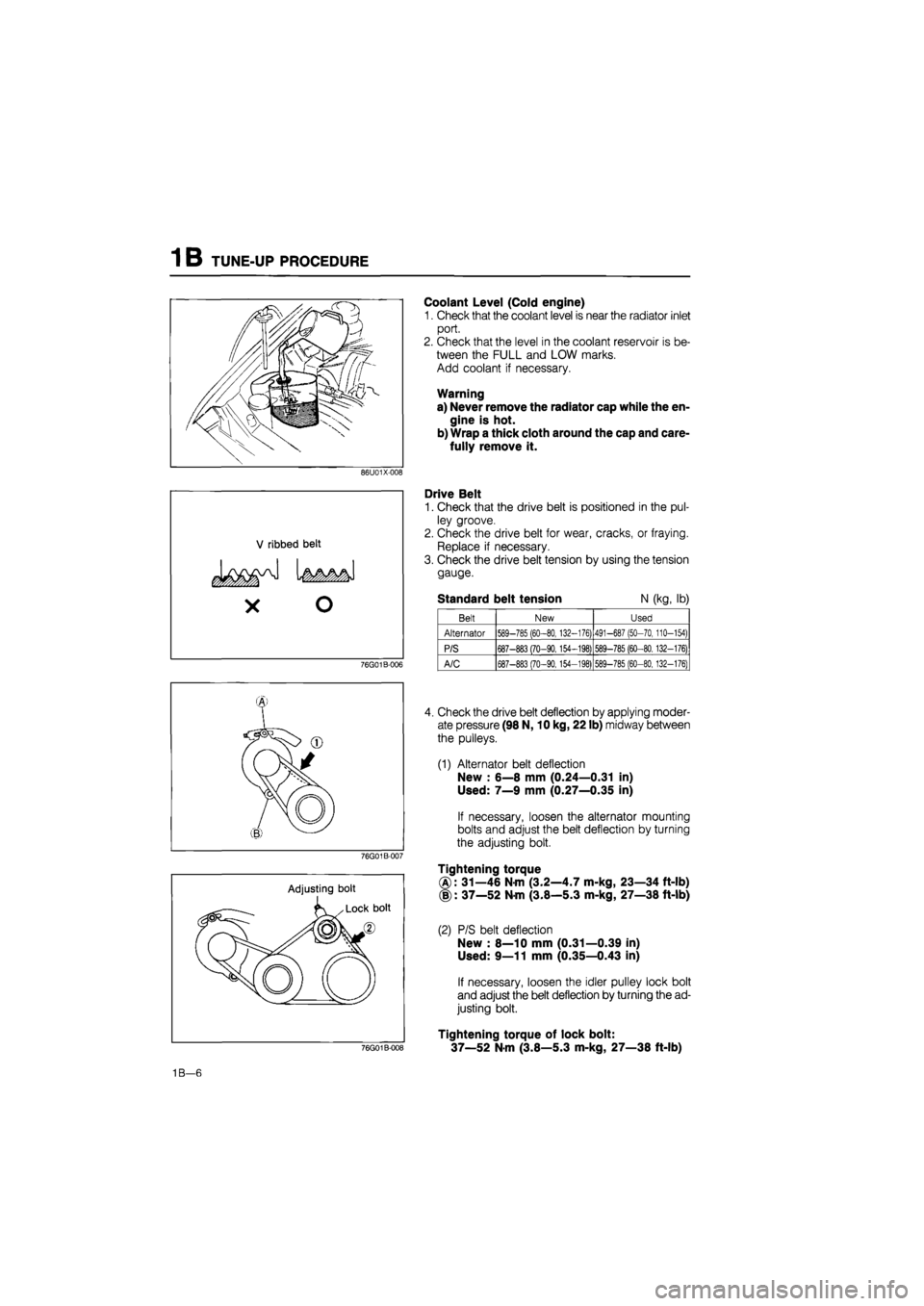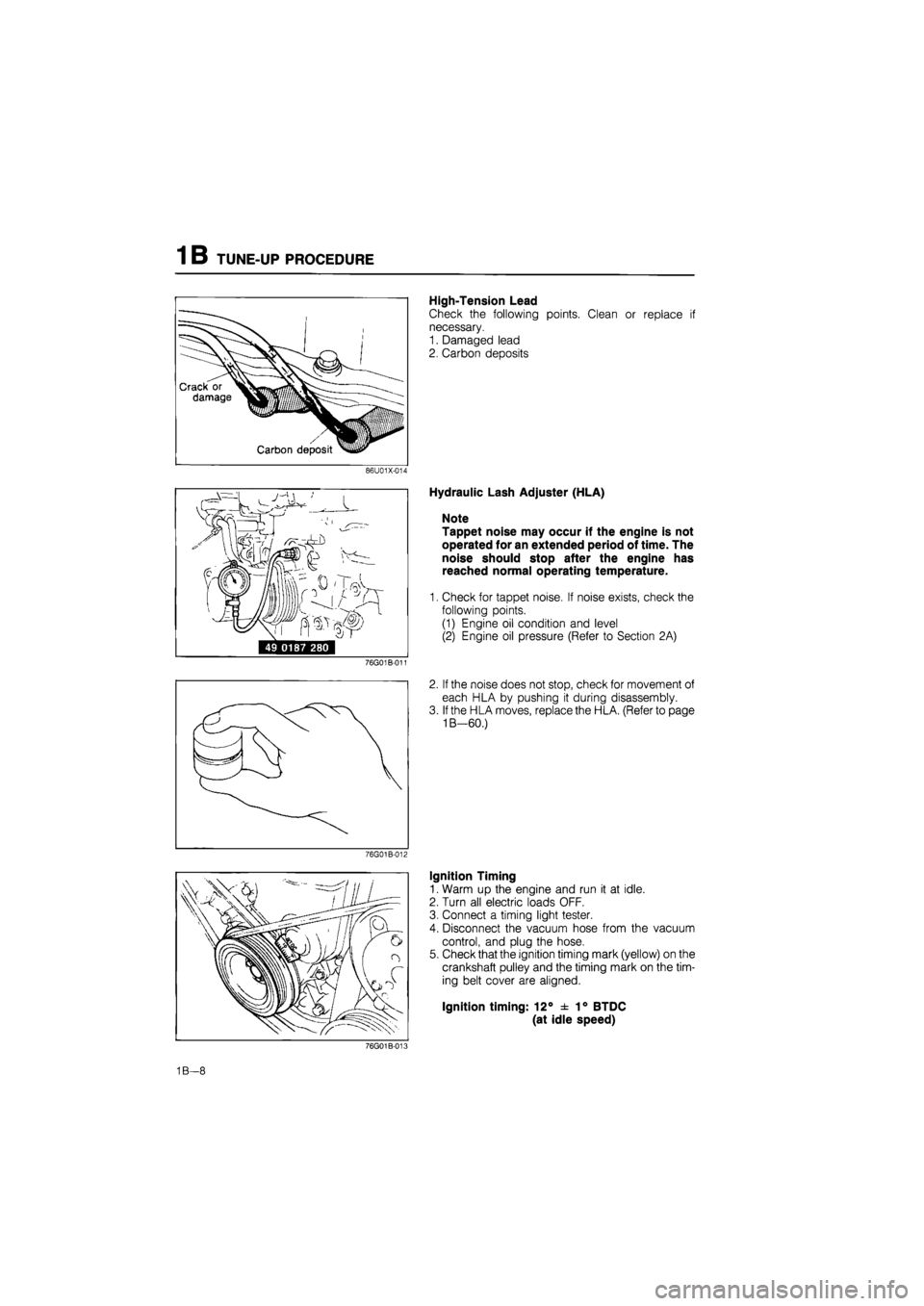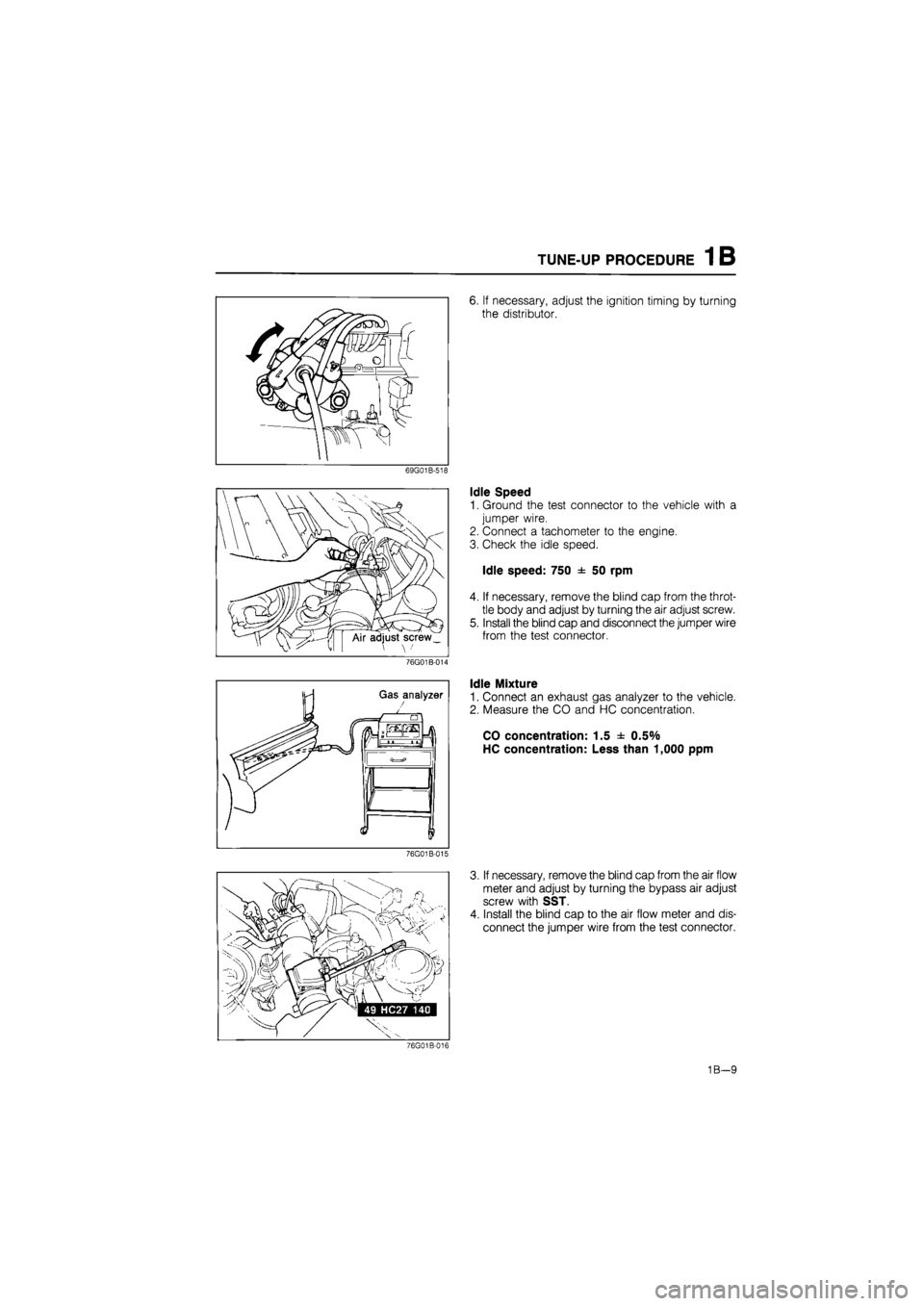MAZDA 626 1987 Workshop Manual
Manufacturer: MAZDA, Model Year: 1987, Model line: 626, Model: MAZDA 626 1987Pages: 1865, PDF Size: 94.35 MB
Page 131 of 1865

INSTALLATION 1A
76G01A-099
76G01A-100
Air Cleaner Assembly
1. Install the air cleaner assembly.
Tightening torque:
16—27
N
m (1.6—2.8 m-kg, 12—20 ft-lb)
2. Connect the air flow sensor connector and air in-
take pipe (Fl).
Engine Oil
Add the specified amount and type of engine oil. (Re-
fer to Section 2A.)
Coolant
Close the drain plug, fill the radiator and reservoir tank
with the specified amount and type of coolant. (Re-
fer to Section 3A.)
Check Engine Condition
1. Check for leaks.
2. Perform engine adjustments if necessary.
3. Perform a road test.
4. Recheck the oil and coolant levels.
86U01X-204
1A—99
Page 132 of 1865

1
ENGINE
(DOHC)
OUTLINE 1B— 2
STRUCTURAL VIEW 1B— 2
SPECIFICATIONS 1B— 3
TROUBLESHOOTING GUIDE 1B— 3
TUNE-UP PROCEDURE IB— 5
ON-VEHICLE INSPECTION 1B—10
COMPRESSION 1B—10
ON-VEHICLE MAINTENANCE 1B—11
TIMING BELT 1B—11
CYLINDER HEAD 1B—16
REMOVAL 1B—22
DISASSEMBLY 1B—24
AUXILIARY PARTS 1B—24
TIMING BELT 1B—26
CYLINDER HEAD 1B—28
CYLINDER BLOCK 1B—30
INSPECTION AND REPAIR 1B—34
ASSEMBLY 1B—48
CYLINDER BLOCK 1B—48
CYLINDER HEAD 1B—59
TIMING BELT 1B—64
AUXILIARY PARTS 1B—68
INSTALLATION 1B—73
TRANSAXLE ASSEMBLY 1B—73
ENGINE INSTALLATION 1B—74
76G01B-001
Page 133 of 1865

1B OUTLINE
OUTLINE
STRUCTURAL VIEW
1B—2
4BG01A-002
Page 134 of 1865

TROUBLESHOOTING GUIDE 1 B
SPECIFICATIONS
Engine model FE DOHC
Item Leaded fuel Unleaded fuel
Type Gasoline, 4 cycle
Cylinder arrangement and number In line, 4 cylinders
Combustion chamber Pentroof
Valve system OHC, belt driven
Displacement cc (cu in) 1,998 (121.9)
Bore and stroke mm (in) 86.0 x 86.0 (3.39 x 3.39)
Compression ratio 10.0 : 1 9.2 : 1
Compression pressure Standard 1,422 (14.5, 206)—290 1,373 (14.0, 199)—310
kPa (kg/cm2, psi)-rpm Minimum 996 (10.2, 144)—290 961 (9.8, 139)—310
IN Open BTDC 10° 10°
Valve timing
IN Close ABDC 60° 55° Valve timing
EX Open BBDC 60° 55° EX Close ATDC 10° 10°
Valve clearance mm (in) IN 0; Maintenance-free Valve clearance mm (in) EX 0; Maintenance-free
Idle speed rpm 750 ± 50
Ignition timing BTDC 12° ± 1°
Firing order 1—3--4-2
76G01B-002
TROUBLESHOOTING GUIDE
Problem Possible Cause Remedy Page
Difficult starting Malfunction of engine-related components
Burned valve
Worn piston, piston ring, or cylinder
Failed cylinder head gasket
Replace
Replace or repair Replace
1B—35 1B—43 1B—16
Malfunction of fuel system Refer to Section 4C
Malfunction of electrical system Refer to Section 5
Poor Idling Malfunction of engine-related components Malfunction of HLA
Poor valve to valve seat contact
Failed cylinder head gasket
Replace
Repair or replace
Replace
1B—60 1B—37 1B—16
Malfunction of fuel system Refer to Section 4C
Excessive oil
consumption Oil working up Worn piston ring groove or sticking piston ring Worn piston or cylinder
Replace
Replace or repair
1B-43 1B-43
Oil working down
Worn valve seal
Worn valve stem or guide
Replace
Replace 1B-35
Oil leakage Refer to Section 2A
76G01B-003
1B—3
Page 135 of 1865

TROUBLESHOOTING GUIDE 1 B
Problem Possible Cause Remedy Page
Insufficient power Insufficient compression Malfunction of HLA Compression leakage from valve seat Seized valve stem Weak or broken valve spring Failed cylinder head gasket Cracked or distorted cylinder head Sticking, damaged, or worn piston ring Cracked or worn piston
Replace Repair
Replace
Replace Replace Replace Replace Replace
1B—60 1B—37 1B—35 1B—38 1B-16 1B—34 1B—43 1B—43
Malfunction of fuel system Refer to Section 4C
Others Slipping clutch Dragging brakes Wrong size tires
Refer to Section 6 Refer to Section 11 Refer to Section 12
Abnormal combustion Malfunction of engine-related components Malfunction of HLA Sticking or burned valve
Weak or broken valve spring Carbon accumulation in combustion chamber
Replace Replace Replace
Eliminate carbon
1B-60
1B-35
1B—38
Malfunction of fuel system Refer to Section 4C
Engine noise Crankshaft or bearing related parts
Excessive main bearing oil clearance Main bearing seized or heat-damaged Excessive crankshaft end play Excessive connecting rod bearing oil clearance Connecting rod bearing seized or heat-damaged
Replace or repair Replace
Replace or repair Replace or repair Replace
1B-51 1B—51 1B—52 1B—53 1B—53
Piston related parts
Worn cylinder Worn piston or piston pin Seized piston Damaged piston ring Bent connecting rod
Replace or repair
Replace
Replace Replace Replace
1B—41 1B-44 1B—43 1B—43 1B-44
Valves or timing related parts Malfunction of HLA* Broken valve spring Excessive valve guide clearance Malfunction of timing belt tensioner
Replace Replace Replace Replace
1B-60 1B—38 1B—35 1B—47
Malfunction of cooling system Refer to Section 3A
Malfunction of fuel system Refer to Section 4C
Others Malfunction of water pump bearing Improper drive belt tension Malfunction of alternator bearing Exhaust gas leakage
Replace Adjust Replace Repair
1B— 6
1B—34
* Tappet noise may occur if the engine is not operated for an extended period of time. The noise should stop after the engine has reached normal operating temperature. 76G01B-004
1B—4
Page 136 of 1865

TUNE-UP PROCEDURE 1 B
76G01A-102
TUNE-UP PROCEDURE
Tune the engine according to the procedures
described below.
Battery
1. Check for corrosion on the terminals, or loose ca-
ble connections.
If necessary, clean the clamps and tighten firmly.
2. Check that the electrolyte level is between the UP-
PER and LOWER marks.
Add distilled water if necessary.
3. Check the specific gravity by using a hydrometer.
If the specific gravity reading is 1.200 or less,
recharge the battery. (Refer to Section 5.)
76G01A-103
Air Cleaner Element
Visually check the air cleaner element for excessive
dirt, damage, or oil. Clean or replace if necessary.
Caution
When cleaning the air cleaner element, blow
dust off from the inside completely first, then
blow from the outside.
76G01B-005
Engine Oil
Check the engine oil level and condition with the oil
level gauge.
Add oil, or change it, if necessary.
4BG01A-010
1B—5
Page 137 of 1865

1B TUNE-UP PROCEDURE 1 B
86U01X-008
Coolant Level (Cold engine)
1. Check that the coolant level is near the radiator inlet
port.
2. Check that the level in the coolant reservoir is be-
tween the FULL and LOW marks.
Add coolant if necessary.
Warning
a) Never remove the radiator cap while the en-
gine is hot.
b) Wrap a thick cloth around the cap and care-
fully remove it.
Drive Belt
1. Check that the drive belt is positioned in the pul-
ley groove.
2. Check the drive belt for wear, cracks, or fraying.
Replace if necessary.
3. Check the drive belt tension by using the tension
gauge.
Standard belt tension N (kg, lb)
76G01B-006
Belt New Used
Alternator 589-785 (60-80, 132-176) 491-687 (50-70, 110-154)
P/S 687-883 (70-90,154-198) 589-785 (60-80.132-176)
A/C 687-883 (70-90,154-198) 589-785 (60-80,132-176)
76G01B-007
Adjusting bolt
76G01B-008
4. Check the drive belt deflection by applying moder-
ate pressure (98 N, 10 kg, 22 lb) midway between
the pulleys.
(1) Alternator belt deflection
New : 6—8 mm (0.24—0.31 in)
Used: 7—9 mm (0.27—0.35 in)
If necessary, loosen the alternator mounting
bolts and adjust the belt deflection by turning
the adjusting bolt.
Tightening torque
®: 31—46 Nm (3.2—4.7 m-kg, 23—34 ft-lb)
(§): 37—52 Nm (3.8—5.3 m-kg, 27—38 ft-lb)
(2) P/S belt deflection
New : 8—10 mm (0.31—0.39 in)
Used: 9—11 mm (0.35—0.43 in)
If necessary, loosen the idler pulley lock bolt
and adjust the belt deflection by turning the ad-
justing bolt.
Tightening torque of lock bolt:
37—52 N-m (3.8—5.3 m-kg, 27—38 ft-lb)
1B—6
Page 138 of 1865

TUNE-UP PROCEDURE 1 B
76G01A-009
76G01A-010
Wear and adhesion of carbon
Burnt
Damage and
deterioration
Damage
76G01B-118
| © © AU
(3) A/C belt deflection
New : 7—9 mm (0.27—0.35 in)
Used: 8—10 mm (0.31—0.39 in)
If necessary, loosen the A/C mounting bolts
and adjust the belt deflection by turning the ad-
justing bolt.
Tightening torque
(A): 37—52
N
m (3.8—5.3 m-kg, 27—38 ft-lb)
(§): 37—52 Nm (3.8—5.3 m-kg, 27—38 ft-lb)
(4) P/S and A/C belt deflection
New : 7—9 mm (0.27—0.35 in)
Used: 8—10 mm (0.31—0.39 in)
If necessary, adjust the belt deflection using the
same procedure as used for the A/C belt
deflection.
Spark Plug
Check the following points. Clean or replace if
necessary.
1. Damaged insulation
2. Worn electrodes
3. Carbon deposits
4. Damaged gasket
5. Burnt spark insulator
6. Plug gap
Plug gap:
0.7—0.8 mm (0.028—0.031 in)
Distributor Cap
Check the following points. Replace if necessary.
1. Cracks or carbon deposits
2. Burnt or corroded terminals
3. Worn distributor center contact
76G01B-008
1B—7
Page 139 of 1865

TUNE-UP PROCEDURE 1 B
High-Tension Lead
Check the following points. Clean or replace if
necessary.
1. Damaged lead
2. Carbon deposits
86U01X-014
i^rrr ' /
49 0187 280
76G01B-011
76G01B-012
Hydraulic Lash Adjuster (HLA)
Note
Tappet noise may occur if the engine is not
operated for an extended period of time. The
noise should stop after the engine has
reached normal operating temperature.
1. Check for tappet noise. If noise exists, check the
following points.
(1) Engine oil condition and level
(2) Engine oil pressure (Refer to Section 2A)
2. If the noise does not stop, check for movement of
each HLA by pushing it during disassembly.
3. If the HLA moves, replace the HLA. (Refer to page
1B—60.)
Ignition Timing
1. Warm up the engine and run it at idle.
2. Turn all electric loads OFF.
3. Connect a timing light tester.
4. Disconnect the vacuum hose from the vacuum
control, and plug the hose.
5. Check that the ignition timing mark (yellow) on the
crankshaft pulley and the timing mark on the tim-
ing belt cover are aligned.
Ignition timing: 12° ± 1° BTDC
(at idle speed)
76G01B-008
1B—8
Page 140 of 1865

TUNE-UP PROCEDURE 1 B
76G01B-015
6. If necessary, adjust the ignition timing by turning
the distributor.
Idle Speed
1. Ground the test connector to the vehicle with a
jumper wire.
2. Connect a tachometer to the engine.
3. Check the idle speed.
Idle speed: 750 ± 50 rpm
4. If necessary, remove the blind cap from the throt-
tle body and adjust by turning the air adjust screw.
5. Install the blind cap and disconnect the jumper wire
from the test connector.
Idle Mixture
1. Connect an exhaust gas analyzer to the vehicle.
2. Measure the CO and HC concentration.
CO concentration: 1.5 ± 0.5%
HC concentration: Less than 1,000 ppm
3. If necessary, remove the blind cap from the air flow
meter and adjust by turning the bypass air adjust
screw with SST.
4. Install the blind cap to the air flow meter and dis-
connect the jumper wire from the test connector.
76G01B-016
1B—9